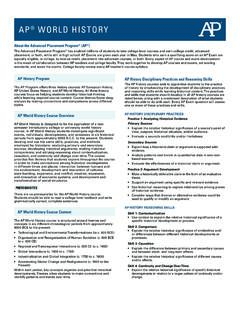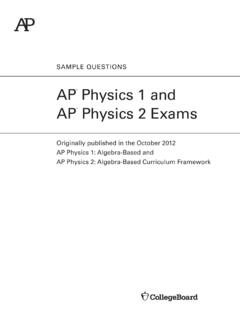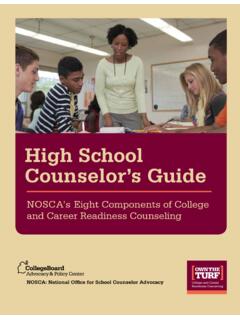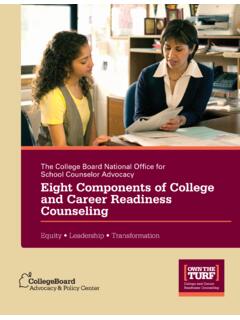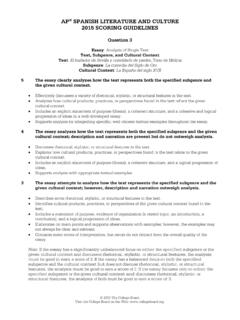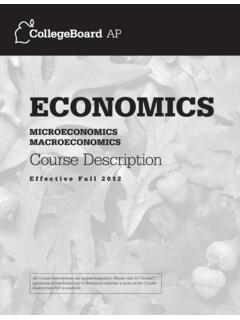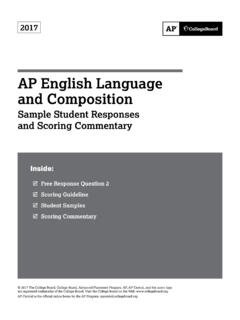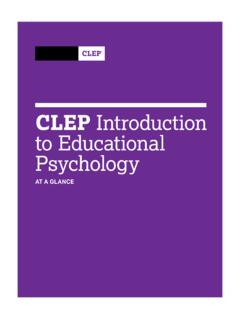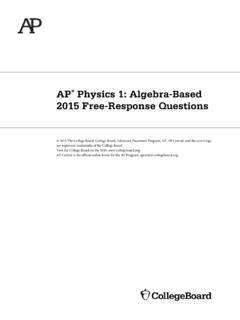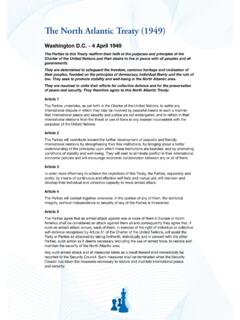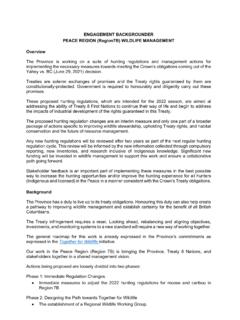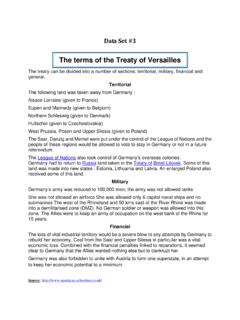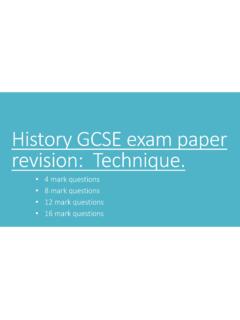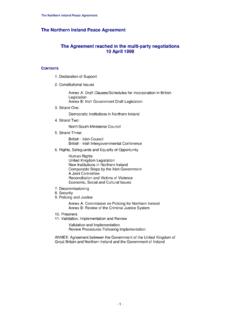Transcription of AP UNITED STATES HISTORY 2016 SCORING GUIDELINES
1 AP UNITED STATES HISTORY 2016 SCORING GUIDELINES 2016 The College Board. Visit the College Board on the Web: Question 3 Evaluate the extent to which UNITED STATES participation in the First World War (1917 1918) marked a turning point in the nation s role in world affairs. In the development of your argument, explain what changed and what stayed the same from the period immediately before the war to the period immediately following it. (Historical thinking skill: Periodization). Maximum Possible Points: 6 Please note: Each point of the rubric is earned independently, , a student could earn the point for synthesis without earning the point for thesis. Unique evidence from the student response is required to earn each point, , evidence in the student response that qualifies for either of the targeted skill points could not be used to earn the point for thesis. A. Thesis (1 point) Targeted Skill: Argumentation (E1) 1 point Presents a thesis that makes a historically defensible claim and responds to all parts of the question.
2 The thesis must consist of one or more sentences located in one place, either in the introduction or the conclusion. 0 points Does not present a thesis that makes a historically defensible claim and responds to all parts of the question. -- Is completely blank. B. Argument Development: Using the Targeted Historical Thinking Skill (2 points) Targeted Skill: Argumentation (E2 and E3) and Periodization (D6) PERIODIZATION: 1 point Describes the ways in which the historical development specified in the prompt was different from OR similar to developments that preceded AND followed. 1 point Explains the extent to which the historical development specified in the prompt was different from AND similar to developments that preceded AND followed. 0 points Does not describe the ways in which the historical development specified in the prompt was different from and similar to developments that preceded AND followed. -- Is completely blank.
3 SCORING Note: For both points, if the prompt requires evaluation of a turning point, then responses must discuss developments that preceded AND followed. For both points, if the prompt requires evaluation of the characteristics of an era, then responses can discuss developments that EITHER preceded OR followed. AP UNITED STATES HISTORY 2016 SCORING GUIDELINES 2016 The College Board. Visit the College Board on the Web: Question 3 (continued) C. Argument Development: Using Evidence (2 points) Targeted Skill: Argumentation (E2 and E3) 1 point Addresses the topic of the question with specific examples of relevant evidence. 1 point Utilizes specific examples of evidence to fully and effectively substantiate the stated thesis or a relevant argument. 0 points Does not address the topic of the question with specific examples of relevant evidence. -- Is completely blank. SCORING Note: To fully and effectively substantiate the stated thesis or a relevant argument, responses must include a broad range of evidence that, through analysis and explanation, justifies the stated thesis or a relevant argument.
4 D. Synthesis (1 point) Targeted Skill: Synthesis (C4 or C5) 1 point Extends the argument by explaining the connections between the argument and ONE of the following: a) A development in a different historical period, situation, era, or geographical area. b) A course theme and/or approach to HISTORY that is not the focus of the essay (such as political, economic, social, cultural, or intellectual HISTORY ). 0 points Does not extend the argument by explaining the connections between the argument and the other areas listed. -- Is completely blank SCORING Note: The synthesis point requires an explanation of the connections to different historical period, situation, era, or geographical area, and is not awarded for merely a phrase or reference. On Accur acy: The components of this rubric each require that students demonstrate historically defensible content knowledge. Given the timed nature of the exam, the essay may contain errors that do not detract from the overall quality, as long as the historical content used to advance the argument is accurate.
5 On Clarity: These essays should be considered first drafts and thus may contain grammatical errors. Those errors will not be counted against a student unless they obscure the successful demonstration of the content knowledge and skills described above. AP UNITED STATES HISTORY 2016 SCORING GUIDELINES 2016 The College Board. Visit the College Board on the Web: Question 3 (continued) SCORING Notes Note: Test-taker responses define the chronological beginning and end points for the essay; the focus of the response helps determine what information is considered appropriate. Note: Student samples are quoted verbatim and may contain grammatical errors. A. Thesis (1 point) Responses earn one point by presenting a thesis that makes a historically defensible claim that responds to all parts of the question (1 point). While the thesis does not need to be a single sentence, it does need to be discrete, meaning it cannot be pieced together from across multiple places within the essay.
6 It can be located in either the introduction or the conclusion, but not split between the two. An acceptable thesis would evaluate the extent to which UNITED STATES participation in the First World War was a turning point, indicating the extent of change OR continuity. Note: Indicating explicitly the extent of change implies the extent of continuity, and vice versa. Examples of acceptable theses: The First World War has been widely considered as the nation s turning point in world affairs. However, it was the Second, not the First World War that really impacted our nation s foreign policy. Although the First World War created a lasting mark internationally, our nation sought to return to a period of isolationism after the war. Before World War One the UNITED STATES attempted to stay as nuetral [sic] and isolated from Europe as possible so as to avoid unnecessary conflict. This had been its foreign policy as much as possible since the days of Washington and the First World War changed that when the UNITED STATES got involved.
7 The war marked a turning point in America s national role to a great extent as it paved the way for more involvement outside of our own country. Unacceptable example of thesis: The following statement does not address the extent of the First World War as a turning point. The UNITED STATES has always been a powerhouse country. The American economy has been strong (despite a couple of bumps) and the people even stronger. The First World War showed the true power of the UNITED STATES due to the willingness of its citizens and the brightness of their minds. B. Argument Development: Using The Targeted Historical Thinking Skill (2 points) a) Argument Development Describes Responses earn one point by describing the ways in which relevant historical developments were different from OR similar to developments that preceded AND followed U nited STATES participation in the First World War (1 point). AP UNITED STATES HISTORY 2016 SCORING GUIDELINES 2016 The College Board.
8 Visit the College Board on the Web: Question 3 (continued) Example of acceptable description of a turning point: Prior to the war, America was not interested in joining the effort.. After successful outcomes within the war with other European countries, the UNITED STATES became a key player in world affairs.. A turning point was made when the UNITED STATES joined World War I because the country was able to gain confidence in their military and political influence.. Although the UNITED STATES never joined the League, the nation still aided its victory and played an influential role at the Paris peace Conference when signing the treaty of Versailles. Example of unacceptable descriptions of a turning point: After WWI .. isolationist sentiment reigned. In fact, most people just wanted to return to the period before the war, thus Republican Warren G. Harding won on the slogan, a return to normalcy & focused on internal affairs during his presidency.
9 Once the Depression began, the dire condition of the UNITED STATES economy was the focus of the American people and presidents.. Overall, the isolationist sentiment of the post WWI America reflected a continuity in UNITED STATES foreign policy that would never be truly broken until WWII. o There is no discussion of events prior to the war, therefore no point is awarded for Periodization. b) Argument Development Explains Responses earn one point by explaining the extent to which relevant historical developments were different from AND similar to developments that preceded AND followed UNITED STATES participation in the First World War (1 point). Example of acceptable explanation of the extent of differences and similarities: The UNITED STATES shift from isolationism to interventionalism [sic] was a drastic change in American foreign policy as the nation switched its views on treatment of the world almost entirely after its participation in World War I.
10 Before the Great War, Americans were wary of the issues that could come about from engaging in foreign affairs and were more than reluctant to join a war half-way across the world.. America s desire to protect democracy was full of passion and is ultimately what caused the drastic change in foreign policy. While the nation did change its mind on involvement with the rest of the world, one fear remained constant.. an unwavering fear of radicals. Example of unacceptable explanation of the extent of differences and similarities: Without the UNITED STATES the League of Nations fell apart and the UNITED STATES remained in the same role in world affairs as it was in before World War I.. After the defeat of the Central Powers, the UNITED STATES was primed to lead the world towards peace and recovery. But the backed down and returned to isolationism and continued its limited role in World Affairs.. Before its entry into WWI the UNITED STATES foreign policy was isolationism, the same policy AP UNITED STATES HISTORY 2016 SCORING GUIDELINES 2016 The College Board.
